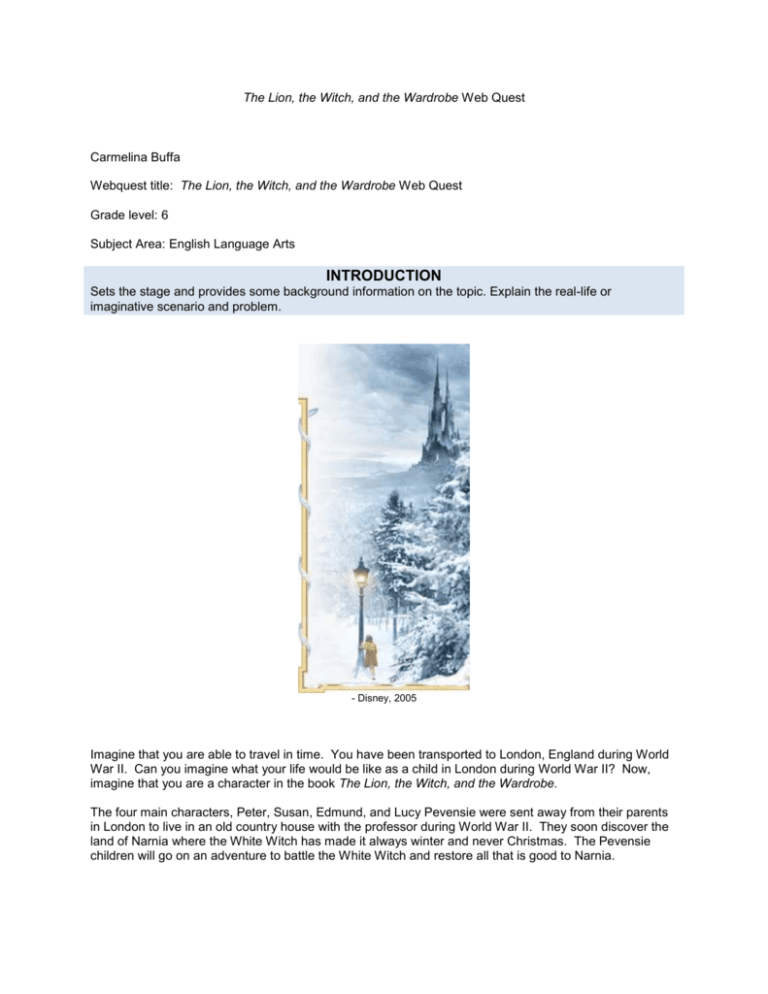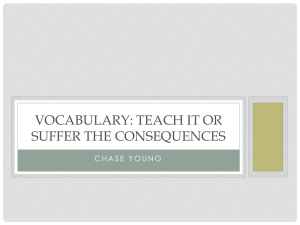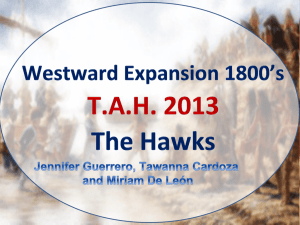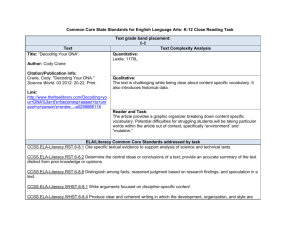The Lion, the Witch, and the Wardrobe Web Quest Carmelina Buffa
advertisement

The Lion, the Witch, and the Wardrobe Web Quest Carmelina Buffa Webquest title: The Lion, the Witch, and the Wardrobe Web Quest Grade level: 6 Subject Area: English Language Arts INTRODUCTION Sets the stage and provides some background information on the topic. Explain the real-life or imaginative scenario and problem. - Disney, 2005 Imagine that you are able to travel in time. You have been transported to London, England during World War II. Can you imagine what your life would be like as a child in London during World War II? Now, imagine that you are a character in the book The Lion, the Witch, and the Wardrobe. The four main characters, Peter, Susan, Edmund, and Lucy Pevensie were sent away from their parents in London to live in an old country house with the professor during World War II. They soon discover the land of Narnia where the White Witch has made it always winter and never Christmas. The Pevensie children will go on an adventure to battle the White Witch and restore all that is good to Narnia. Have you ever wondered where authors get their ideas for their books? Are there any connections between the life of the author of The Lion, the Witch, and the Wardrobe, C.S. Lewis, and life in London, England during World War II? TASK Explains the research task and the graded assignment task. atschool.eduweb.co.uk 1. Imagine that you were living in London England during World War II. Write a diary or journal describing what your life was like, what your experiences were, and what your thoughts and feelings would have been. You must include at least three entries. Use the links listed below to help collect information about that particular time period. 2. Write a biography about C.S. Lewis. Please utilize the links below for research. Explain how the author’s personal life is reflected in the novel. The biography should be between 1-2 pages typed using one inch margins and size 12 Times New Roman font in MLA style format. Use these links for activity #1: (Please conduct additional research utilizing other websites, if necessary) Children and World War II Images of London during WWII Food Rationing During WWII World War II London Blitz Video Evacuation of Children Use these links for activity #2: (Please conduct additional research utilizing other websites, if necessary) C.S. Lewis Biography C.S. Lewis - Biography Online C.S. Lewis Web Site RESEARCH RESOURCES Lists the Internet web sites needed to complete the research task. - Deborah Maze (Harper Collins, 2004) Use these links for activity #1: (Please conduct additional research utilizing other websites, if necessary) Children and World War II Images of London during WWII Food Rationing During WWII World War II London Blitz Video Evacuation of Children Use these links for activity #2: (Please conduct additional research utilizing other websites, if necessary) C.S. Lewis Biography C.S. Lewis - Biography Online C.S. Lewis Web Site Some questions you may want to think about: * What makes C.S. Lewis special or interesting? * What kind of effect did his life have on his writing or stories? * What are the adjectives you would most use to describe the C.S. Lewis? * What examples from his life illustrate those qualities in the novel, The Lion, the Witch, and the Wardrobe? * What events shaped or changed his life? * Did he overcome any obstacles? PROCESS Provides step-by-step instructions for how to do the research and assignment tasks. en.wikipedia.org C. S. Lewis as a boy in Belfast, Ireland, prior to his mother's death in 1908. cslewis.com (Harper Collins, 2008) Activity #1 1. 2. 3. 4. 5. 6. Please click on the Children and World War II link to begin activity #1. Take notes as you read about the children and why they were evacuated. Click on the Images of London during WWII link. Try to imagine yourself there and jot down things that you see. Click on the Food Rationing During WWII link. Write down information about you and your family members. Who would receive what and how often? 7. Click on the World War II London Blitz Video and the Evacuation of Children videos. 8. Watch these short YouTube videos and envision yourself during this time. What would you be feeling and/or thinking? Write down your thoughts. Why were children evacuated? 9. Utilize your notes to create a diary/journal (with at least 3 entries) describing what your life was like, what your experiences were, and what your thoughts and feelings would have been had you lived as a child during World War II. Activity #2 Please click on the links C.S. Lewis Biography, C.S. Lewis - Biography Online, C.S. Lewis Web Site, to collect all necessary information for your biography. Please take notes from all of the links you utilize. Please consider these questions as you gather information: * What makes him special or interesting? * What kind of effect did his life have on his writing or stories? * What are the adjectives you would most use to describe the C.S. Lewis? * What examples from his life illustrate those qualities in the novel, The Lion, the Witch, and the Wardrobe? * What events shaped or changed his life? * Did he overcome any obstacles? EVALUATION RUBRIC Lists performance-based criteria for grading. Rubric for Activity #1: Diary/Journal Entries CATEGORY Creativity 4 The entries contain many creative details and/or descriptions that contribute to the piece. The author has really used his/her imagination. 3 The entries contain a few creative details and/or descriptions that contribute to the piece. The author has used his/her imagination. Accuracy of Facts All facts presented in the entries are accurate. Almost all facts presented in the entries are accurate. Requirements All of the written requirements (# of entries, format, etc.) were met. Almost all (about 90%) the written requirements were met. Spelling and Punctuation There are no spelling or punctuation errors in the final draft. The setting and names that the author used are spelled consistently throughout. The final draft of the entries is readable, clean, neat and attractive. It is free of erasures and crossed-out words. It looks like the author took great pride in it. There is one spelling or punctuation error in the final draft. Neatness The final draft of the entries is readable, neat and attractive. It may have one or two erasures, but they are not distracting. It looks like the author took some pride in it. 2 The entries contain a few creative details and/or descriptions, but they distract from the story. The author has tried to use his/her imagination. Most facts presented in the entries are accurate (at least 70%). Most (about 75%) of the written requirements were met, but several were not. There are 2-3 spelling and punctuation errors in the final draft. 1 There is little evidence of creativity in the entries. The author does not seem to have used much imagination. The final draft of the entries is readable and some of the pages are attractive. It looks like parts of it might have been done in a hurry. The final draft is not neat or attractive. It looks like the student just wanted to get it done and didn't care what it looked like. There are several factual errors in the entries. Many requirements were not met. The final draft has more than 3 spelling and punctuation errors. Disney Rubric for Activity #2: Research Report: C.S. Lewis Biography CATEGORY 4 Organization Information is very organized with well-constructed paragraphs and subheadings Information clearly relates to the main topic. It includes several supporting details and/or examples Successfully uses suggested Internet links to find information and navigates within these sites easily without assistance Information is organized with well-constructed paragraphs Information is organized, but paragraphs are not well-constructed The information appears to be disorganized Information clearly relates to the main topic. It provides 12 supporting details and/or examples Usually able to use suggested Internet links to find information and navigates within these sites easily without assistance Information clearly relates to the main topic. No details and/or examples are given Information has little or nothing to do with the main topic Needs assistance or supervision to use suggested Internet links and/or to navigate within these sites Sources All sources (information and graphics) are accurately documented in the desired format Mechanics No grammatical, spelling, or punctuation errors All sources (information and graphics) are accurately documented, but a few are not in the desired format Almost no grammatical, spelling, or punctuation errors Occasionally able to use suggested Internet links to find information and navigates within these sites easily without assistance All sources (information and graphics) are accurately documented, but many are not in the desired format A few grammatical, spelling, or punctuation errors. Quality of Information Internet Use 3 2 1 Some sources are not accurately documented Many grammatical, spelling, or punctuation errors CONCLUSION Brings closure to the Web Quest by providing questions for reflection on what was learned, and/or providing additional web links for further study and research. Movie City News, 2005 You have made your way back to the current year, and you have returned safely. Did you take notes while you were there? Did you see anything interesting? What would your life have been like in London during World War II? Do you think that an author’s life influences his/her works? Your journey does not have to end just yet. Click on this link to play a game: Narnia Game - Prince Caspian or Narnia Games Click here to: Talking with Mr. Tumnus Click this link for WWII Interactive Games (then click on games) TEACHER INTRODUCTION This Web Quest was created to allow students to engage in the novel The Lion, the Witch, and the Wardrobe from both a historical and a literary approach. The Web Quest will supplement the class lessons and activities that are based on the sections of the novel. Students navigate the Internet, read critically and synthesize information, write a biography, and create a diary/journal utilizing both a historical and literal approach. The Web Quest provides supplemental lessons for The Lion, the Witch, and the Wardrobe to enhance the students’ development. STANDARDS Standards for New Jersey: 21st Century Skills In grades 5-8, students expand their capacity to use operations and applications, apply information-literacy skills, and select the appropriate tools and resources to accomplish a variety of tasks, as they develop digital citizenship. As students participate in online learning communities, collaborating in the design of products that address local and global issues across the curriculum, they build understanding of the perspectives of learners from other countries. Students at this level can apply the design process in the development of products; understand impact constraints, trade-offs, and resource selection; and solve a design challenge and/or build a prototype using the design process. Students can explain why human-designed systems, products, and environments need to be monitored, maintained, and improved, and they recognize the interdependence of subsystems as parts of a system. CCSS.ELA-Literacy.RL.6.1 Cite textual evidence to support analysis of what the text says explicitly as well as inferences drawn from the text. CCSS.ELA-Literacy.RL.6.2 Determine a theme or central idea of a text and how it is conveyed through particular details; provide a summary of the text distinct from personal opinions or judgments. CCSS.ELA-Literacy.RL.6.3 Describe how a particular story’s or drama’s plot unfolds in a series of episodes as well as how the characters respond or change as the plot moves toward a resolution. CCSS.ELA-Literacy.RL.6.4 Determine the meaning of words and phrases as they are used in a text, including figurative and connotative meanings; analyze the impact of a specific word choice on meaning and tone CCSS.ELA-Literacy.RL.6.5 Analyze how a particular sentence, chapter, scene, or stanza fits into the overall structure of a text and contributes to the development of the theme, setting, or plot. CCSS.ELA-Literacy.RL.6.6 Explain how an author develops the point of view of the narrator or speaker in a text. CCSS.ELA-Literacy.RL.6.7 Compare and contrast the experience of reading a story, drama, or poem to listening to or viewing an audio, video, or live version of the text, including contrasting what they “see” and “hear” when reading the text to what they perceive when they listen or watch. CCSS.ELA-Literacy.RL.6.9 Compare and contrast texts in different forms or genres (e.g., stories and poems; historical novels and fantasy stories) in terms of their approaches to similar themes and topics. CCSS.ELA-Literacy.RI.6.1 Cite textual evidence to support analysis of what the text says explicitly as well as inferences drawn from the text. CCSS.ELA-Literacy.RI.6.2 Determine a central idea of a text and how it is conveyed through particular details; provide a summary of the text distinct from personal opinions or judgments. CCSS.ELA-Literacy.RI.6.4 Determine the meaning of words and phrases as they are used in a text, including figurative, connotative, and technical meanings. CCSS.ELA-Literacy.RI.6.5 Analyze how a particular sentence, paragraph, chapter, or section fits into the overall structure of a text and contributes to the development of the ideas. CCSS.ELA-Literacy.RI.6.6 Determine an author’s point of view or purpose in a text and explain how it is conveyed in the text. CCSS.ELA-Literacy.RI.6.7 Integrate information presented in different media or formats (e.g., visually, quantitatively) as well as in words to develop a coherent understanding of a topic or issue. CCSS.ELA-Literacy.W.6.1a Introduce claim(s) and organize the reasons and evidence clearly. CCSS.ELA-Literacy.W.6.1b Support claim(s) with clear reasons and relevant evidence, using credible sources and demonstrating an understanding of the topic or text. CCSS.ELA-Literacy.W.6.1c Use words, phrases, and clauses to clarify the relationships among claim(s) and reasons. CCSS.ELA-Literacy.W.6.1d Establish and maintain a formal style. CCSS.ELA-Literacy.W.6.2a Introduce a topic; organize ideas, concepts, and information, using strategies such as definition, classification, comparison/contrast, and cause/effect; include formatting (e.g., headings), graphics (e.g., charts, tables), and multimedia when useful to aiding comprehension. CCSS.ELA-Literacy.W.6.2b Develop the topic with relevant facts, definitions, concrete details, quotations, or other information and examples. CCSS.ELA-Literacy.W.6.2c Use appropriate transitions to clarify the relationships among ideas and concepts. CCSS.ELA-Literacy.W.6.2d Use precise language and domain-specific vocabulary to inform about or explain the topic. CCSS.ELA-Literacy.W.6.2e Establish and maintain a formal style. CCSS.ELA-Literacy.W.6.3a Engage and orient the reader by establishing a context and introducing a narrator and/or characters; organize an event sequence that unfolds naturally and logically. CCSS.ELA-Literacy.W.6.3b Use narrative techniques, such as dialogue, pacing, and description, to develop experiences, events, and/or characters. CCSS.ELA-Literacy.W.6.3c Use a variety of transition words, phrases, and clauses to convey sequence and signal shifts from one time frame or setting to another. CCSS.ELA-Literacy.W.6.3d Use precise words and phrases, relevant descriptive details, and sensory language to convey experiences and events. CCSS.ELA-Literacy.W.6.3e Provide a conclusion that follows from the narrated experiences or events. CCSS.ELA-Literacy.W.6.4 Produce clear and coherent writing in which the development, organization, and style are appropriate to task, purpose, and audience. (Grade-specific expectations for writing types are defined in standards 1–3 above.) CCSS.ELA-Literacy.W.6.5 With some guidance and support from peers and adults, develop and strengthen writing as needed by planning, revising, editing, rewriting, or trying a new approach. CCSS.ELA-Literacy.W.6.6 Use technology, including the Internet, to produce and publish writing as well as to interact and collaborate with others; demonstrate sufficient command of keyboarding skills to type a minimum of three pages in a single sitting. CCSS.ELA-Literacy.W.6.7 Conduct short research projects to answer a question, drawing on several sources and refocusing the inquiry when appropriate. CCSS.ELA-Literacy.W.6.8 Gather relevant information from multiple print and digital sources; assess the credibility of each source; and quote or paraphrase the data and conclusions of others while avoiding plagiarism and providing basic bibliographic information for sources. CCSS.ELA-Literacy.W.6.10 Write routinely over extended time frames (time for research, reflection, and revision) and shorter time frames (a single sitting or a day or two) for a range of discipline-specific tasks, purposes, and audiences. CCSS.ELA-Literacy.SL.6.2 Interpret information presented in diverse media and formats (e.g., visually, quantitatively, orally) and explain how it contributes to a topic, text, or issue under study. CCSS.ELA-Literacy.L.6.1e Recognize variations from standard English in their own and others' writing and speaking, and identify and use strategies to improve expression in conventional language. CCSS.ELA-Literacy.L.6.2a Use punctuation (commas, parentheses, dashes) to set off nonrestrictive/parenthetical elements. CCSS.ELA-Literacy.L.6.2b Spell correctly. CCSS.ELA-Literacy.L.6.3a Vary sentence patterns for meaning, reader/listener interest, and style.* CCSS.ELA-Literacy.L.6.3b Maintain consistency in style and tone. CCSS.ELA-Literacy.L.6.4c Consult reference materials (e.g., dictionaries, glossaries, thesauruses), both print and digital, to find the pronunciation of a word or determine or clarify its precise meaning or its part of speech. LEARNERS The intended learners of The Lion, the Witch, and the Wardrobe Web Quest are grade 6 English Language Arts students. TEACHER RESOURCES * The Lion, the Witch, and the Wardrobe by C.S. Lewis (one copy per student) * Computers with Internet access * State of New Jersey Department of Education website for Standards TEACHER PROCESS Students should have individual access to computers with Internet access. If this is not feasible, students may work in groups and collaborate to gather information. Teachers may wish to assign the Web Quest in pairs or groups for ELL learners or for differentiated instruction. CREDITS The Lion, the Witch and the Wardrobe, C.S. Lewis Thank you to all those who provided resources or help. Thank you to all of the creators of the websites depicting World War II, The Lion, the Witch, and the Wardrobe, and/or C.S. Lewis. Thank you to the technology department who helped the students to review the basic functions necessary to complete their assignments. Images are from wikepedia.com, Disney.com, cslewis.com, and moviecitynews.com.





![iPads_and_Writing_2013[1]](http://s2.studylib.net/store/data/005383991_1-1bc8c0f2382c2ccb89e094c534f531f0-300x300.png)


